Analyzing HRM Practices at Marks and Spencer: A Detailed Report
VerifiedAdded on 2021/01/03
|21
|7233
|428
Report
AI Summary
This report provides a comprehensive analysis of Human Resource Management (HRM) practices at Marks and Spencer. It begins by outlining the purpose and functions of HRM, focusing on how Marks and Spencer utilizes these principles to enhance productivity and retain talent. The report then delves into the strengths and weaknesses of different recruitment and selection methods, including internal and external recruitment, job analysis, and the use of written tests and interviews. Furthermore, it examines the benefits of various HRM practices for both employers and employees, as well as their impact on organizational profit and productivity. The role of employee relations and the influence of employment legislation on HRM decision-making processes are also explored. Finally, the report applies HRM practices in a work-related context, offering practical insights and concluding with a summary of the key findings and recommendations for Marks and Spencer's HRM strategies. The report is a contribution to Desklib, a platform offering AI-powered study tools and resources for students.
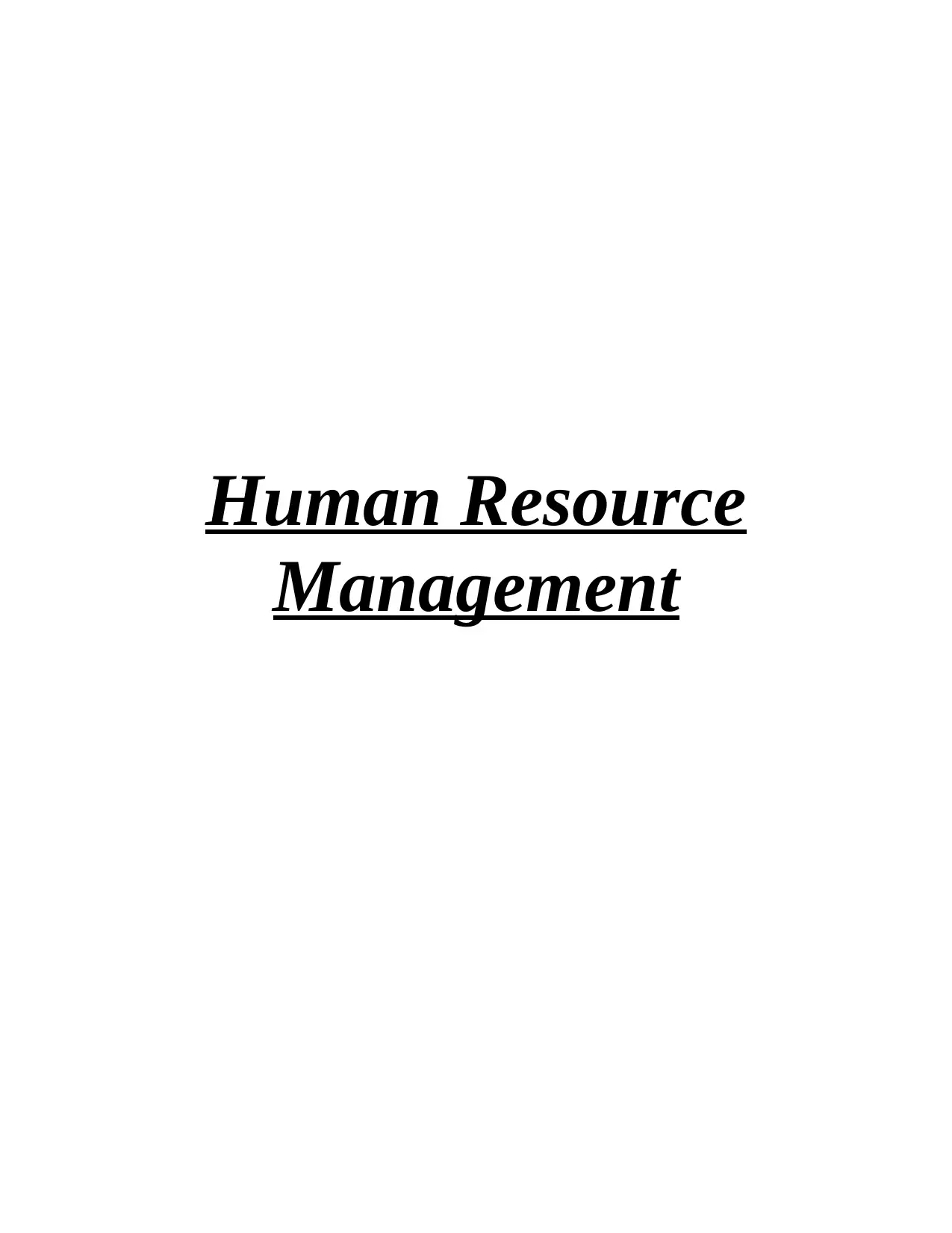
Human Resource
Management
Management
Paraphrase This Document
Need a fresh take? Get an instant paraphrase of this document with our AI Paraphraser
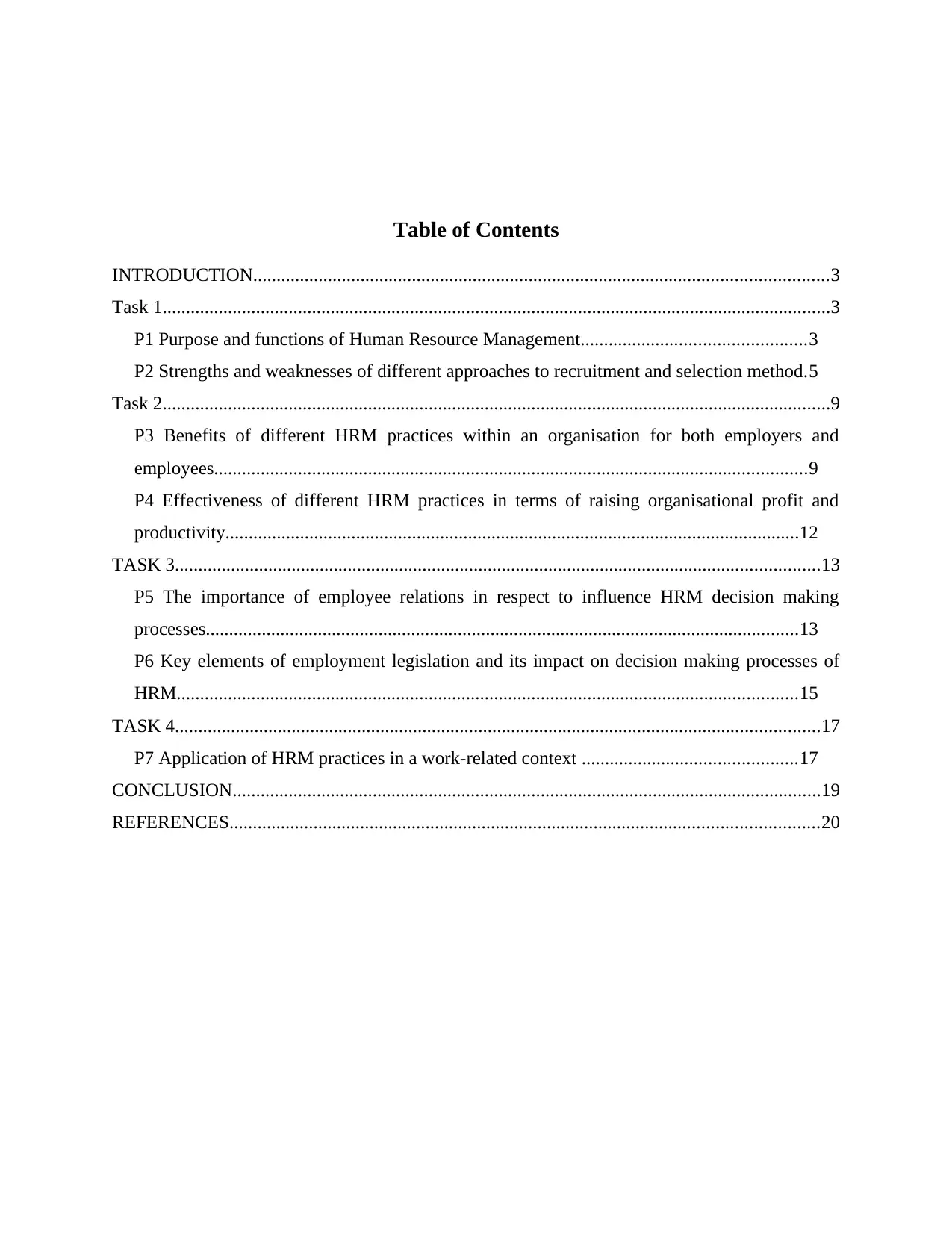
Table of Contents
INTRODUCTION...........................................................................................................................3
Task 1...............................................................................................................................................3
P1 Purpose and functions of Human Resource Management................................................3
P2 Strengths and weaknesses of different approaches to recruitment and selection method.5
Task 2...............................................................................................................................................9
P3 Benefits of different HRM practices within an organisation for both employers and
employees...............................................................................................................................9
P4 Effectiveness of different HRM practices in terms of raising organisational profit and
productivity...........................................................................................................................12
TASK 3..........................................................................................................................................13
P5 The importance of employee relations in respect to influence HRM decision making
processes...............................................................................................................................13
P6 Key elements of employment legislation and its impact on decision making processes of
HRM.....................................................................................................................................15
TASK 4..........................................................................................................................................17
P7 Application of HRM practices in a work-related context ..............................................17
CONCLUSION..............................................................................................................................19
REFERENCES..............................................................................................................................20
INTRODUCTION...........................................................................................................................3
Task 1...............................................................................................................................................3
P1 Purpose and functions of Human Resource Management................................................3
P2 Strengths and weaknesses of different approaches to recruitment and selection method.5
Task 2...............................................................................................................................................9
P3 Benefits of different HRM practices within an organisation for both employers and
employees...............................................................................................................................9
P4 Effectiveness of different HRM practices in terms of raising organisational profit and
productivity...........................................................................................................................12
TASK 3..........................................................................................................................................13
P5 The importance of employee relations in respect to influence HRM decision making
processes...............................................................................................................................13
P6 Key elements of employment legislation and its impact on decision making processes of
HRM.....................................................................................................................................15
TASK 4..........................................................................................................................................17
P7 Application of HRM practices in a work-related context ..............................................17
CONCLUSION..............................................................................................................................19
REFERENCES..............................................................................................................................20
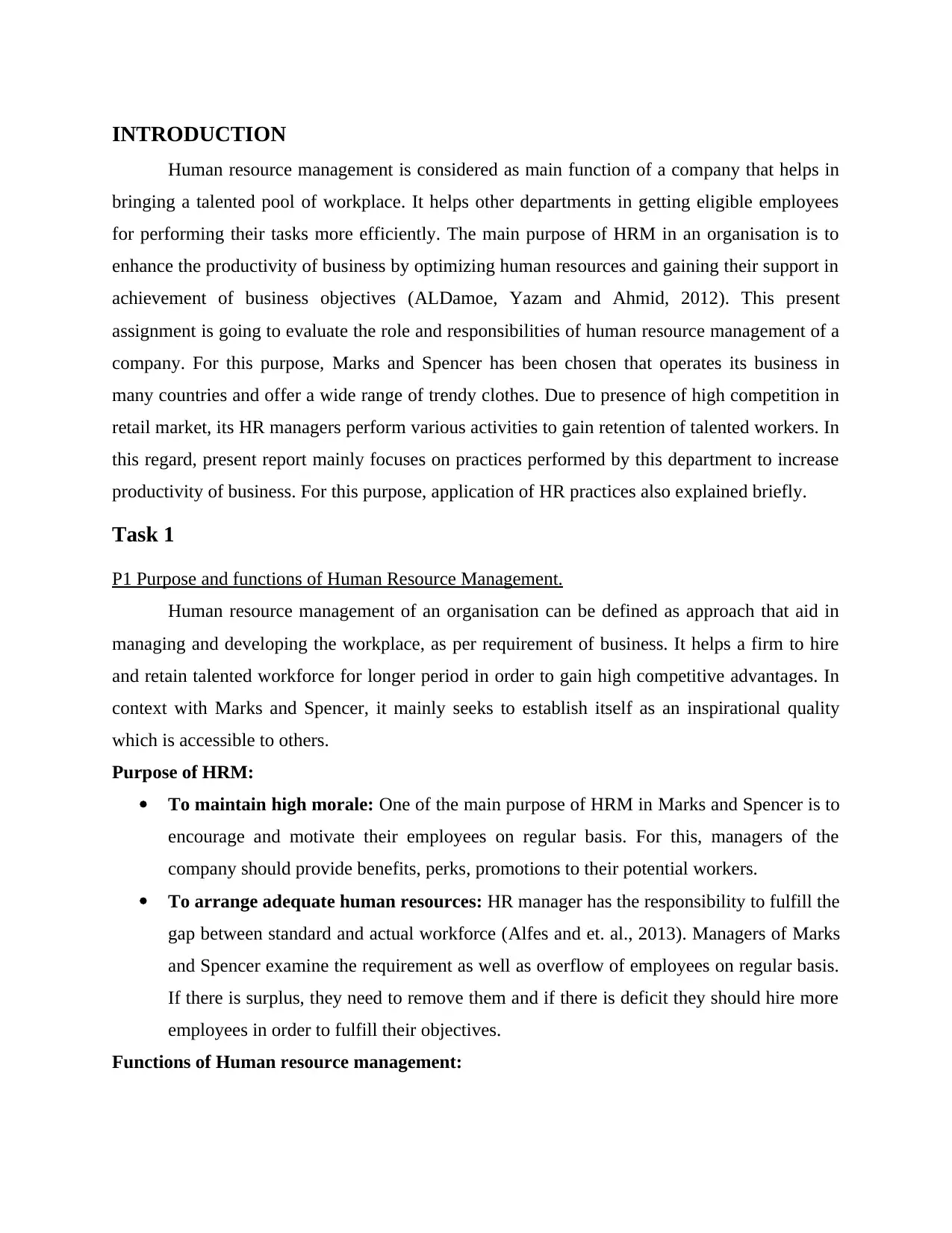
INTRODUCTION
Human resource management is considered as main function of a company that helps in
bringing a talented pool of workplace. It helps other departments in getting eligible employees
for performing their tasks more efficiently. The main purpose of HRM in an organisation is to
enhance the productivity of business by optimizing human resources and gaining their support in
achievement of business objectives (ALDamoe, Yazam and Ahmid, 2012). This present
assignment is going to evaluate the role and responsibilities of human resource management of a
company. For this purpose, Marks and Spencer has been chosen that operates its business in
many countries and offer a wide range of trendy clothes. Due to presence of high competition in
retail market, its HR managers perform various activities to gain retention of talented workers. In
this regard, present report mainly focuses on practices performed by this department to increase
productivity of business. For this purpose, application of HR practices also explained briefly.
Task 1
P1 Purpose and functions of Human Resource Management.
Human resource management of an organisation can be defined as approach that aid in
managing and developing the workplace, as per requirement of business. It helps a firm to hire
and retain talented workforce for longer period in order to gain high competitive advantages. In
context with Marks and Spencer, it mainly seeks to establish itself as an inspirational quality
which is accessible to others.
Purpose of HRM:
To maintain high morale: One of the main purpose of HRM in Marks and Spencer is to
encourage and motivate their employees on regular basis. For this, managers of the
company should provide benefits, perks, promotions to their potential workers.
To arrange adequate human resources: HR manager has the responsibility to fulfill the
gap between standard and actual workforce (Alfes and et. al., 2013). Managers of Marks
and Spencer examine the requirement as well as overflow of employees on regular basis.
If there is surplus, they need to remove them and if there is deficit they should hire more
employees in order to fulfill their objectives.
Functions of Human resource management:
Human resource management is considered as main function of a company that helps in
bringing a talented pool of workplace. It helps other departments in getting eligible employees
for performing their tasks more efficiently. The main purpose of HRM in an organisation is to
enhance the productivity of business by optimizing human resources and gaining their support in
achievement of business objectives (ALDamoe, Yazam and Ahmid, 2012). This present
assignment is going to evaluate the role and responsibilities of human resource management of a
company. For this purpose, Marks and Spencer has been chosen that operates its business in
many countries and offer a wide range of trendy clothes. Due to presence of high competition in
retail market, its HR managers perform various activities to gain retention of talented workers. In
this regard, present report mainly focuses on practices performed by this department to increase
productivity of business. For this purpose, application of HR practices also explained briefly.
Task 1
P1 Purpose and functions of Human Resource Management.
Human resource management of an organisation can be defined as approach that aid in
managing and developing the workplace, as per requirement of business. It helps a firm to hire
and retain talented workforce for longer period in order to gain high competitive advantages. In
context with Marks and Spencer, it mainly seeks to establish itself as an inspirational quality
which is accessible to others.
Purpose of HRM:
To maintain high morale: One of the main purpose of HRM in Marks and Spencer is to
encourage and motivate their employees on regular basis. For this, managers of the
company should provide benefits, perks, promotions to their potential workers.
To arrange adequate human resources: HR manager has the responsibility to fulfill the
gap between standard and actual workforce (Alfes and et. al., 2013). Managers of Marks
and Spencer examine the requirement as well as overflow of employees on regular basis.
If there is surplus, they need to remove them and if there is deficit they should hire more
employees in order to fulfill their objectives.
Functions of Human resource management:
⊘ This is a preview!⊘
Do you want full access?
Subscribe today to unlock all pages.

Trusted by 1+ million students worldwide
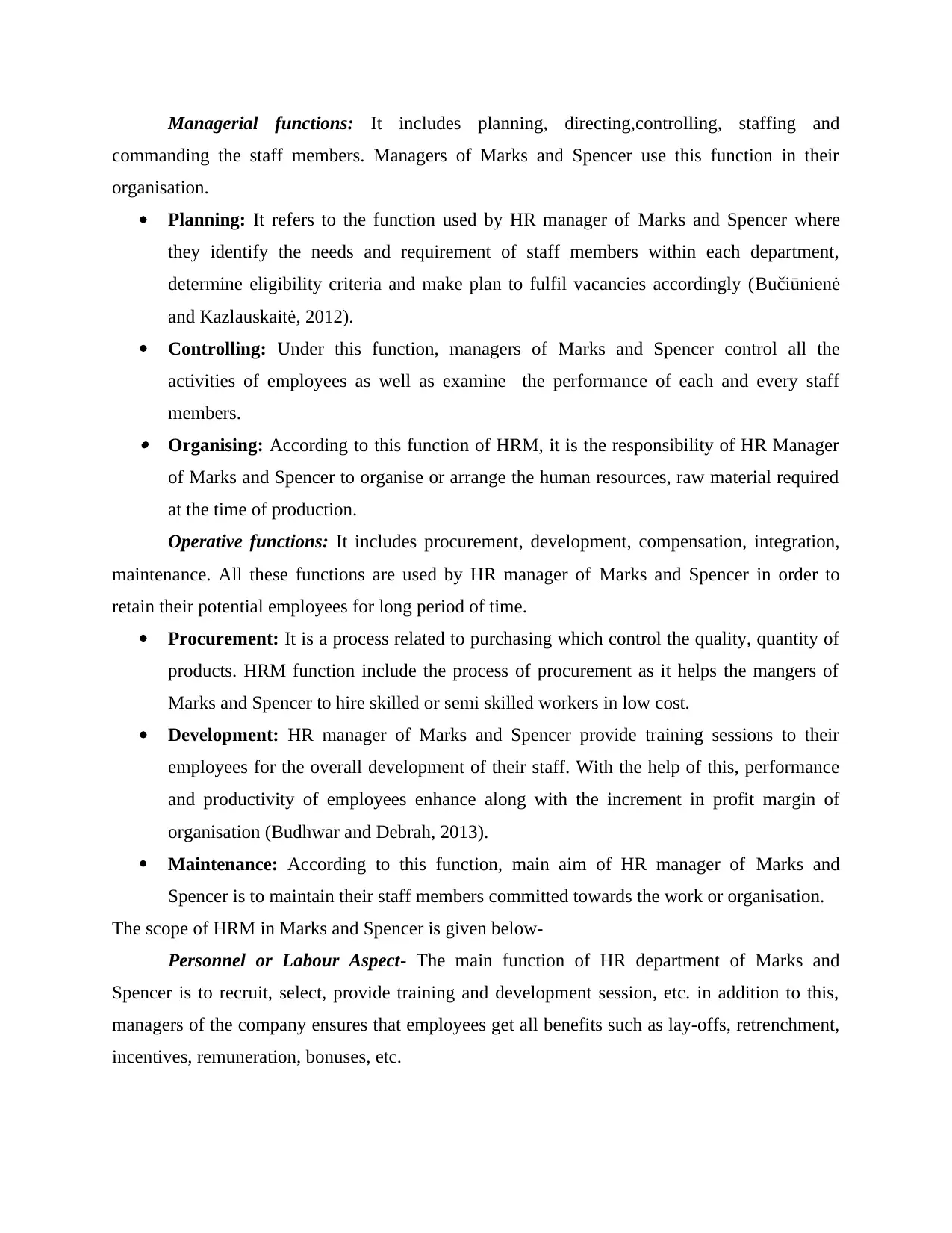
Managerial functions: It includes planning, directing,controlling, staffing and
commanding the staff members. Managers of Marks and Spencer use this function in their
organisation.
Planning: It refers to the function used by HR manager of Marks and Spencer where
they identify the needs and requirement of staff members within each department,
determine eligibility criteria and make plan to fulfil vacancies accordingly (Bučiūnienė
and Kazlauskaitė, 2012).
Controlling: Under this function, managers of Marks and Spencer control all the
activities of employees as well as examine the performance of each and every staff
members. Organising: According to this function of HRM, it is the responsibility of HR Manager
of Marks and Spencer to organise or arrange the human resources, raw material required
at the time of production.
Operative functions: It includes procurement, development, compensation, integration,
maintenance. All these functions are used by HR manager of Marks and Spencer in order to
retain their potential employees for long period of time.
Procurement: It is a process related to purchasing which control the quality, quantity of
products. HRM function include the process of procurement as it helps the mangers of
Marks and Spencer to hire skilled or semi skilled workers in low cost.
Development: HR manager of Marks and Spencer provide training sessions to their
employees for the overall development of their staff. With the help of this, performance
and productivity of employees enhance along with the increment in profit margin of
organisation (Budhwar and Debrah, 2013).
Maintenance: According to this function, main aim of HR manager of Marks and
Spencer is to maintain their staff members committed towards the work or organisation.
The scope of HRM in Marks and Spencer is given below-
Personnel or Labour Aspect- The main function of HR department of Marks and
Spencer is to recruit, select, provide training and development session, etc. in addition to this,
managers of the company ensures that employees get all benefits such as lay-offs, retrenchment,
incentives, remuneration, bonuses, etc.
commanding the staff members. Managers of Marks and Spencer use this function in their
organisation.
Planning: It refers to the function used by HR manager of Marks and Spencer where
they identify the needs and requirement of staff members within each department,
determine eligibility criteria and make plan to fulfil vacancies accordingly (Bučiūnienė
and Kazlauskaitė, 2012).
Controlling: Under this function, managers of Marks and Spencer control all the
activities of employees as well as examine the performance of each and every staff
members. Organising: According to this function of HRM, it is the responsibility of HR Manager
of Marks and Spencer to organise or arrange the human resources, raw material required
at the time of production.
Operative functions: It includes procurement, development, compensation, integration,
maintenance. All these functions are used by HR manager of Marks and Spencer in order to
retain their potential employees for long period of time.
Procurement: It is a process related to purchasing which control the quality, quantity of
products. HRM function include the process of procurement as it helps the mangers of
Marks and Spencer to hire skilled or semi skilled workers in low cost.
Development: HR manager of Marks and Spencer provide training sessions to their
employees for the overall development of their staff. With the help of this, performance
and productivity of employees enhance along with the increment in profit margin of
organisation (Budhwar and Debrah, 2013).
Maintenance: According to this function, main aim of HR manager of Marks and
Spencer is to maintain their staff members committed towards the work or organisation.
The scope of HRM in Marks and Spencer is given below-
Personnel or Labour Aspect- The main function of HR department of Marks and
Spencer is to recruit, select, provide training and development session, etc. in addition to this,
managers of the company ensures that employees get all benefits such as lay-offs, retrenchment,
incentives, remuneration, bonuses, etc.
Paraphrase This Document
Need a fresh take? Get an instant paraphrase of this document with our AI Paraphraser
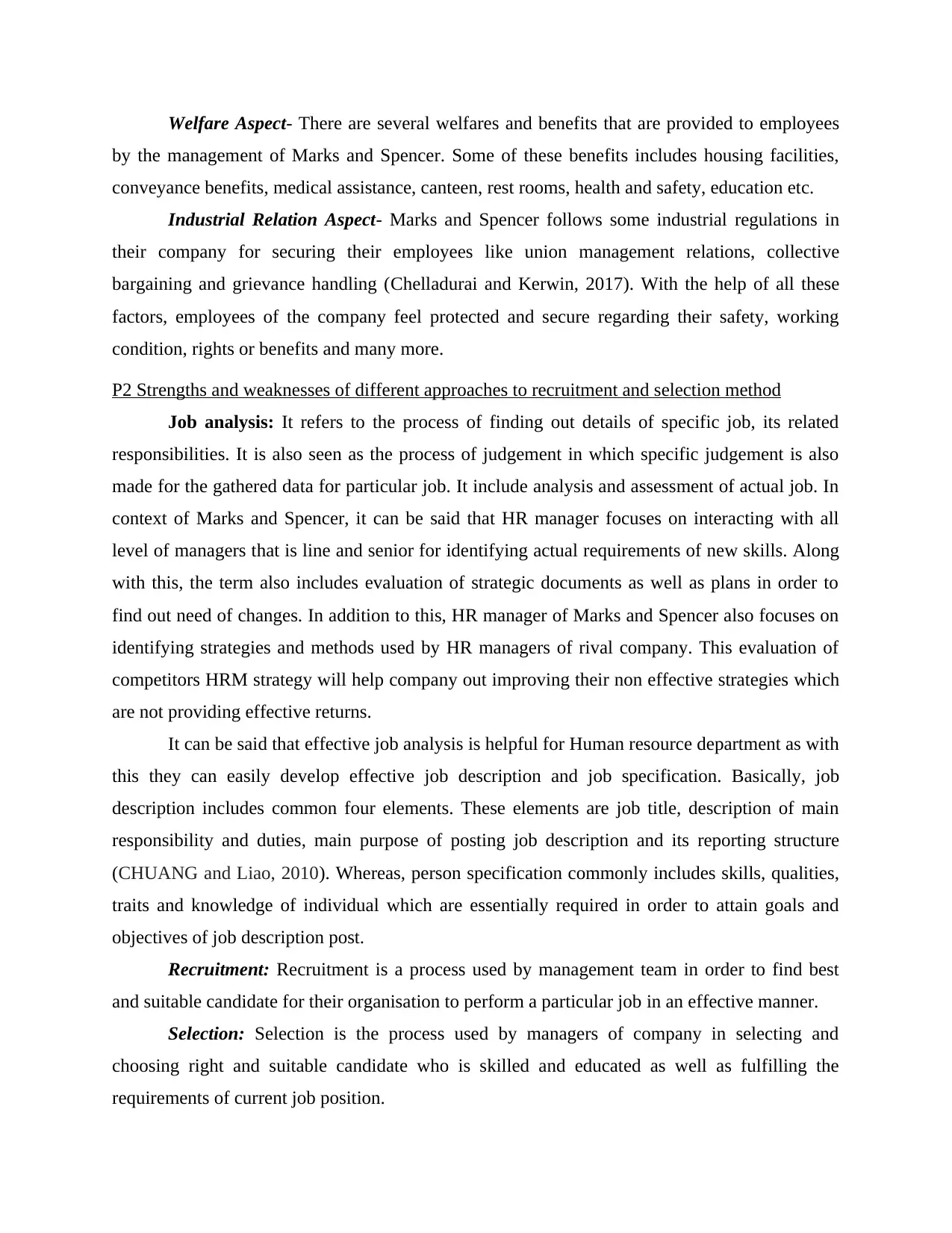
Welfare Aspect- There are several welfares and benefits that are provided to employees
by the management of Marks and Spencer. Some of these benefits includes housing facilities,
conveyance benefits, medical assistance, canteen, rest rooms, health and safety, education etc.
Industrial Relation Aspect- Marks and Spencer follows some industrial regulations in
their company for securing their employees like union management relations, collective
bargaining and grievance handling (Chelladurai and Kerwin, 2017). With the help of all these
factors, employees of the company feel protected and secure regarding their safety, working
condition, rights or benefits and many more.
P2 Strengths and weaknesses of different approaches to recruitment and selection method
Job analysis: It refers to the process of finding out details of specific job, its related
responsibilities. It is also seen as the process of judgement in which specific judgement is also
made for the gathered data for particular job. It include analysis and assessment of actual job. In
context of Marks and Spencer, it can be said that HR manager focuses on interacting with all
level of managers that is line and senior for identifying actual requirements of new skills. Along
with this, the term also includes evaluation of strategic documents as well as plans in order to
find out need of changes. In addition to this, HR manager of Marks and Spencer also focuses on
identifying strategies and methods used by HR managers of rival company. This evaluation of
competitors HRM strategy will help company out improving their non effective strategies which
are not providing effective returns.
It can be said that effective job analysis is helpful for Human resource department as with
this they can easily develop effective job description and job specification. Basically, job
description includes common four elements. These elements are job title, description of main
responsibility and duties, main purpose of posting job description and its reporting structure
(CHUANG and Liao, 2010). Whereas, person specification commonly includes skills, qualities,
traits and knowledge of individual which are essentially required in order to attain goals and
objectives of job description post.
Recruitment: Recruitment is a process used by management team in order to find best
and suitable candidate for their organisation to perform a particular job in an effective manner.
Selection: Selection is the process used by managers of company in selecting and
choosing right and suitable candidate who is skilled and educated as well as fulfilling the
requirements of current job position.
by the management of Marks and Spencer. Some of these benefits includes housing facilities,
conveyance benefits, medical assistance, canteen, rest rooms, health and safety, education etc.
Industrial Relation Aspect- Marks and Spencer follows some industrial regulations in
their company for securing their employees like union management relations, collective
bargaining and grievance handling (Chelladurai and Kerwin, 2017). With the help of all these
factors, employees of the company feel protected and secure regarding their safety, working
condition, rights or benefits and many more.
P2 Strengths and weaknesses of different approaches to recruitment and selection method
Job analysis: It refers to the process of finding out details of specific job, its related
responsibilities. It is also seen as the process of judgement in which specific judgement is also
made for the gathered data for particular job. It include analysis and assessment of actual job. In
context of Marks and Spencer, it can be said that HR manager focuses on interacting with all
level of managers that is line and senior for identifying actual requirements of new skills. Along
with this, the term also includes evaluation of strategic documents as well as plans in order to
find out need of changes. In addition to this, HR manager of Marks and Spencer also focuses on
identifying strategies and methods used by HR managers of rival company. This evaluation of
competitors HRM strategy will help company out improving their non effective strategies which
are not providing effective returns.
It can be said that effective job analysis is helpful for Human resource department as with
this they can easily develop effective job description and job specification. Basically, job
description includes common four elements. These elements are job title, description of main
responsibility and duties, main purpose of posting job description and its reporting structure
(CHUANG and Liao, 2010). Whereas, person specification commonly includes skills, qualities,
traits and knowledge of individual which are essentially required in order to attain goals and
objectives of job description post.
Recruitment: Recruitment is a process used by management team in order to find best
and suitable candidate for their organisation to perform a particular job in an effective manner.
Selection: Selection is the process used by managers of company in selecting and
choosing right and suitable candidate who is skilled and educated as well as fulfilling the
requirements of current job position.
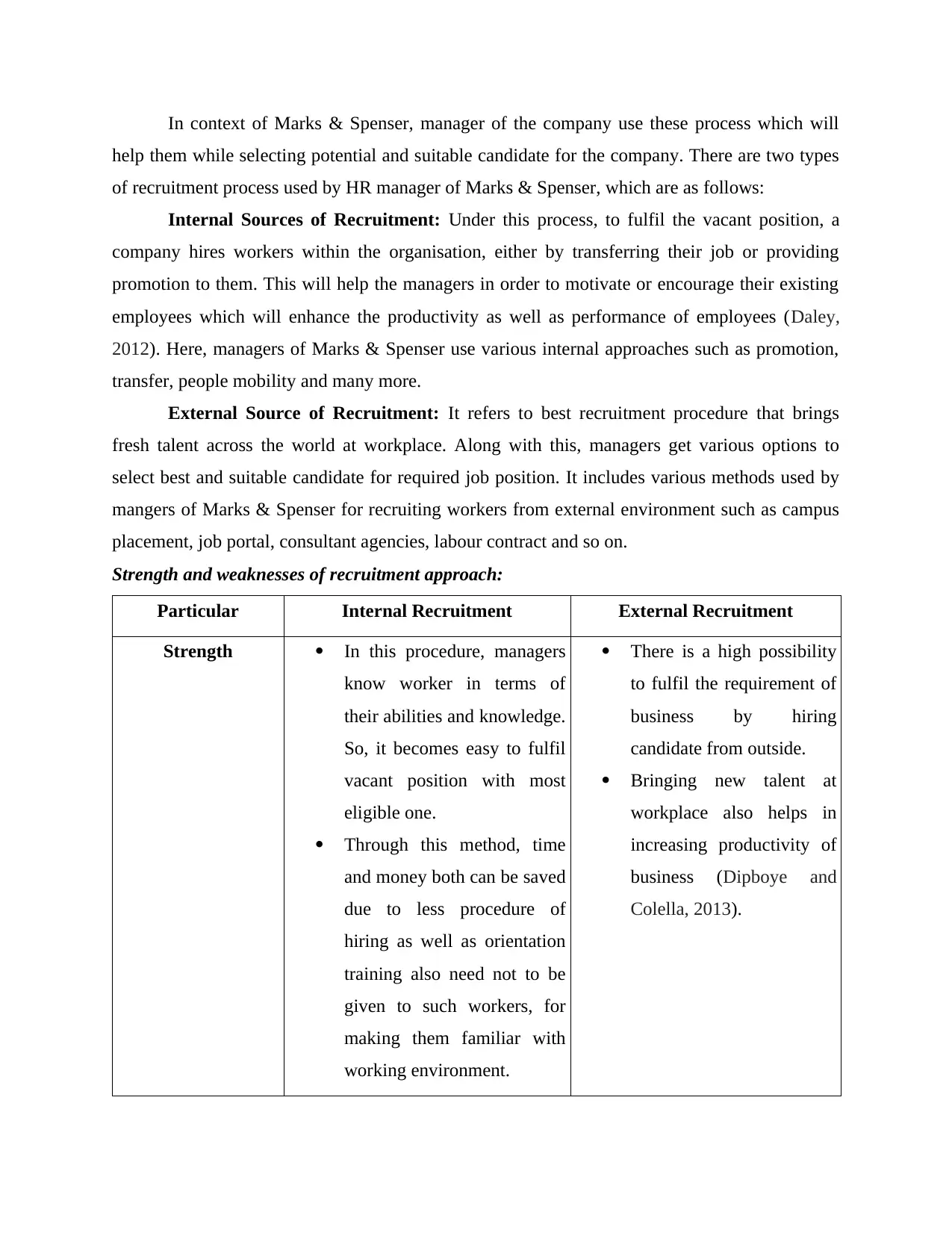
In context of Marks & Spenser, manager of the company use these process which will
help them while selecting potential and suitable candidate for the company. There are two types
of recruitment process used by HR manager of Marks & Spenser, which are as follows:
Internal Sources of Recruitment: Under this process, to fulfil the vacant position, a
company hires workers within the organisation, either by transferring their job or providing
promotion to them. This will help the managers in order to motivate or encourage their existing
employees which will enhance the productivity as well as performance of employees (Daley,
2012). Here, managers of Marks & Spenser use various internal approaches such as promotion,
transfer, people mobility and many more.
External Source of Recruitment: It refers to best recruitment procedure that brings
fresh talent across the world at workplace. Along with this, managers get various options to
select best and suitable candidate for required job position. It includes various methods used by
mangers of Marks & Spenser for recruiting workers from external environment such as campus
placement, job portal, consultant agencies, labour contract and so on.
Strength and weaknesses of recruitment approach:
Particular Internal Recruitment External Recruitment
Strength In this procedure, managers
know worker in terms of
their abilities and knowledge.
So, it becomes easy to fulfil
vacant position with most
eligible one.
Through this method, time
and money both can be saved
due to less procedure of
hiring as well as orientation
training also need not to be
given to such workers, for
making them familiar with
working environment.
There is a high possibility
to fulfil the requirement of
business by hiring
candidate from outside.
Bringing new talent at
workplace also helps in
increasing productivity of
business (Dipboye and
Colella, 2013).
help them while selecting potential and suitable candidate for the company. There are two types
of recruitment process used by HR manager of Marks & Spenser, which are as follows:
Internal Sources of Recruitment: Under this process, to fulfil the vacant position, a
company hires workers within the organisation, either by transferring their job or providing
promotion to them. This will help the managers in order to motivate or encourage their existing
employees which will enhance the productivity as well as performance of employees (Daley,
2012). Here, managers of Marks & Spenser use various internal approaches such as promotion,
transfer, people mobility and many more.
External Source of Recruitment: It refers to best recruitment procedure that brings
fresh talent across the world at workplace. Along with this, managers get various options to
select best and suitable candidate for required job position. It includes various methods used by
mangers of Marks & Spenser for recruiting workers from external environment such as campus
placement, job portal, consultant agencies, labour contract and so on.
Strength and weaknesses of recruitment approach:
Particular Internal Recruitment External Recruitment
Strength In this procedure, managers
know worker in terms of
their abilities and knowledge.
So, it becomes easy to fulfil
vacant position with most
eligible one.
Through this method, time
and money both can be saved
due to less procedure of
hiring as well as orientation
training also need not to be
given to such workers, for
making them familiar with
working environment.
There is a high possibility
to fulfil the requirement of
business by hiring
candidate from outside.
Bringing new talent at
workplace also helps in
increasing productivity of
business (Dipboye and
Colella, 2013).
⊘ This is a preview!⊘
Do you want full access?
Subscribe today to unlock all pages.

Trusted by 1+ million students worldwide
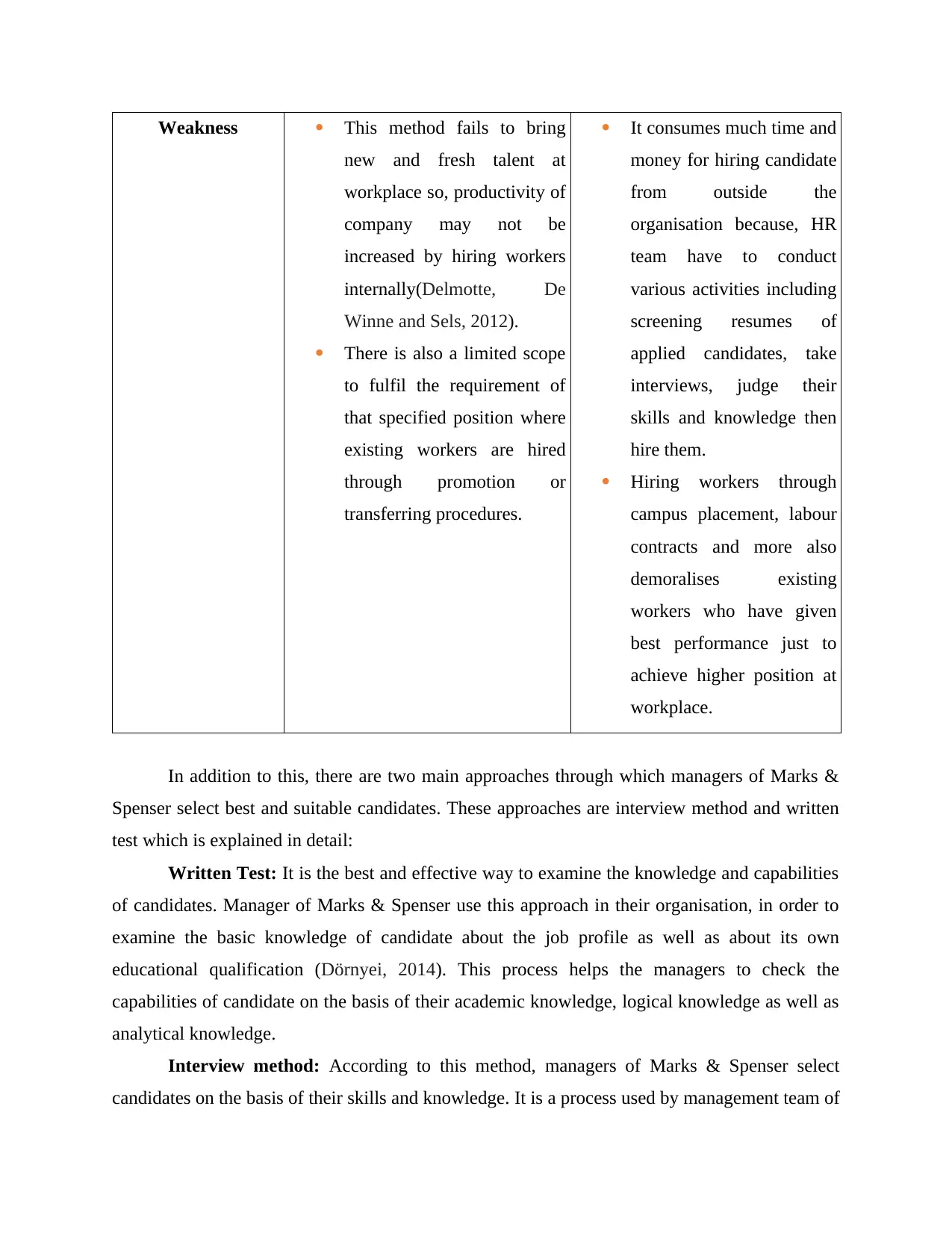
Weakness This method fails to bring
new and fresh talent at
workplace so, productivity of
company may not be
increased by hiring workers
internally(Delmotte, De
Winne and Sels, 2012).
There is also a limited scope
to fulfil the requirement of
that specified position where
existing workers are hired
through promotion or
transferring procedures.
It consumes much time and
money for hiring candidate
from outside the
organisation because, HR
team have to conduct
various activities including
screening resumes of
applied candidates, take
interviews, judge their
skills and knowledge then
hire them.
Hiring workers through
campus placement, labour
contracts and more also
demoralises existing
workers who have given
best performance just to
achieve higher position at
workplace.
In addition to this, there are two main approaches through which managers of Marks &
Spenser select best and suitable candidates. These approaches are interview method and written
test which is explained in detail:
Written Test: It is the best and effective way to examine the knowledge and capabilities
of candidates. Manager of Marks & Spenser use this approach in their organisation, in order to
examine the basic knowledge of candidate about the job profile as well as about its own
educational qualification (Dörnyei, 2014). This process helps the managers to check the
capabilities of candidate on the basis of their academic knowledge, logical knowledge as well as
analytical knowledge.
Interview method: According to this method, managers of Marks & Spenser select
candidates on the basis of their skills and knowledge. It is a process used by management team of
new and fresh talent at
workplace so, productivity of
company may not be
increased by hiring workers
internally(Delmotte, De
Winne and Sels, 2012).
There is also a limited scope
to fulfil the requirement of
that specified position where
existing workers are hired
through promotion or
transferring procedures.
It consumes much time and
money for hiring candidate
from outside the
organisation because, HR
team have to conduct
various activities including
screening resumes of
applied candidates, take
interviews, judge their
skills and knowledge then
hire them.
Hiring workers through
campus placement, labour
contracts and more also
demoralises existing
workers who have given
best performance just to
achieve higher position at
workplace.
In addition to this, there are two main approaches through which managers of Marks &
Spenser select best and suitable candidates. These approaches are interview method and written
test which is explained in detail:
Written Test: It is the best and effective way to examine the knowledge and capabilities
of candidates. Manager of Marks & Spenser use this approach in their organisation, in order to
examine the basic knowledge of candidate about the job profile as well as about its own
educational qualification (Dörnyei, 2014). This process helps the managers to check the
capabilities of candidate on the basis of their academic knowledge, logical knowledge as well as
analytical knowledge.
Interview method: According to this method, managers of Marks & Spenser select
candidates on the basis of their skills and knowledge. It is a process used by management team of
Paraphrase This Document
Need a fresh take? Get an instant paraphrase of this document with our AI Paraphraser
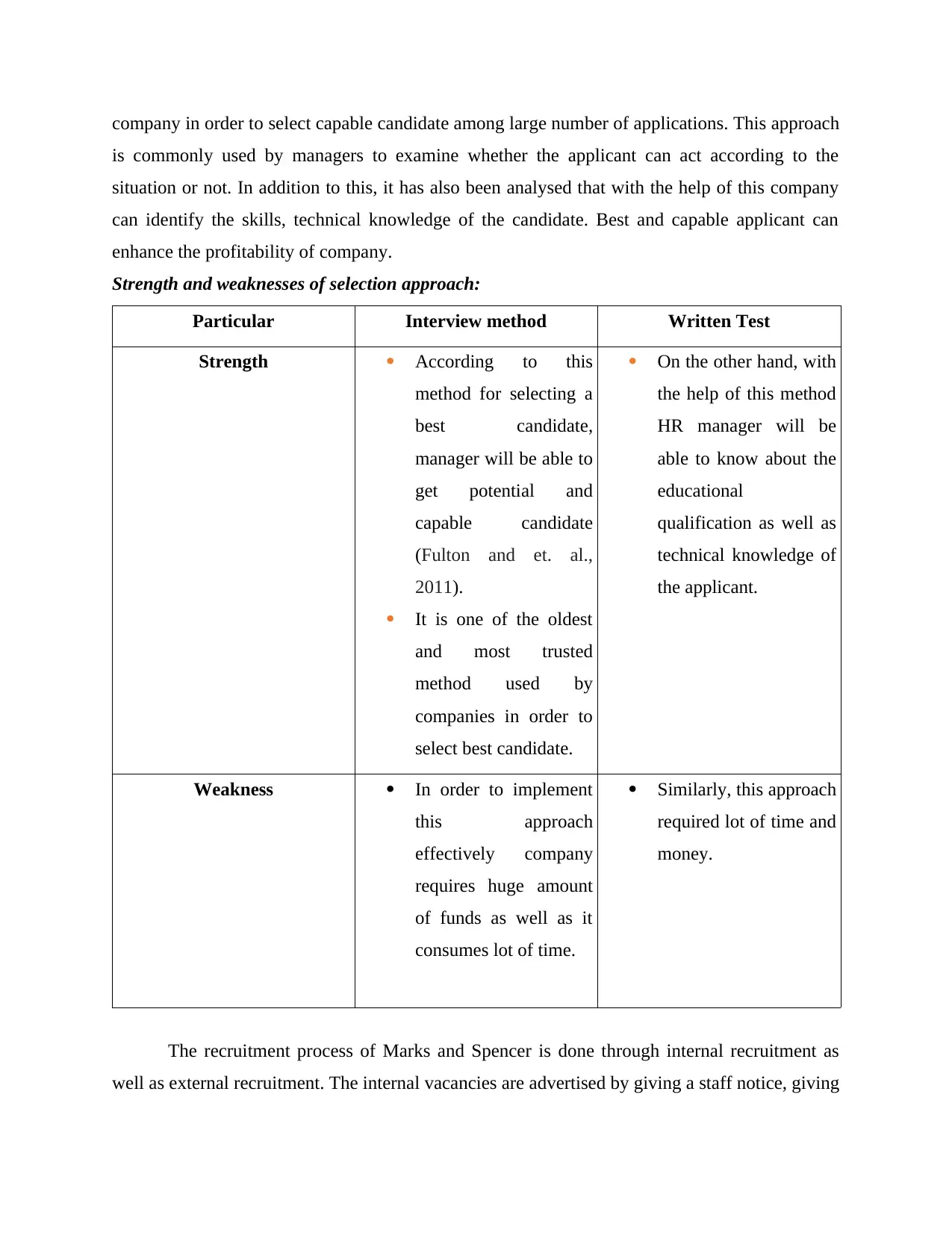
company in order to select capable candidate among large number of applications. This approach
is commonly used by managers to examine whether the applicant can act according to the
situation or not. In addition to this, it has also been analysed that with the help of this company
can identify the skills, technical knowledge of the candidate. Best and capable applicant can
enhance the profitability of company.
Strength and weaknesses of selection approach:
Particular Interview method Written Test
Strength According to this
method for selecting a
best candidate,
manager will be able to
get potential and
capable candidate
(Fulton and et. al.,
2011).
It is one of the oldest
and most trusted
method used by
companies in order to
select best candidate.
On the other hand, with
the help of this method
HR manager will be
able to know about the
educational
qualification as well as
technical knowledge of
the applicant.
Weakness In order to implement
this approach
effectively company
requires huge amount
of funds as well as it
consumes lot of time.
Similarly, this approach
required lot of time and
money.
The recruitment process of Marks and Spencer is done through internal recruitment as
well as external recruitment. The internal vacancies are advertised by giving a staff notice, giving
is commonly used by managers to examine whether the applicant can act according to the
situation or not. In addition to this, it has also been analysed that with the help of this company
can identify the skills, technical knowledge of the candidate. Best and capable applicant can
enhance the profitability of company.
Strength and weaknesses of selection approach:
Particular Interview method Written Test
Strength According to this
method for selecting a
best candidate,
manager will be able to
get potential and
capable candidate
(Fulton and et. al.,
2011).
It is one of the oldest
and most trusted
method used by
companies in order to
select best candidate.
On the other hand, with
the help of this method
HR manager will be
able to know about the
educational
qualification as well as
technical knowledge of
the applicant.
Weakness In order to implement
this approach
effectively company
requires huge amount
of funds as well as it
consumes lot of time.
Similarly, this approach
required lot of time and
money.
The recruitment process of Marks and Spencer is done through internal recruitment as
well as external recruitment. The internal vacancies are advertised by giving a staff notice, giving
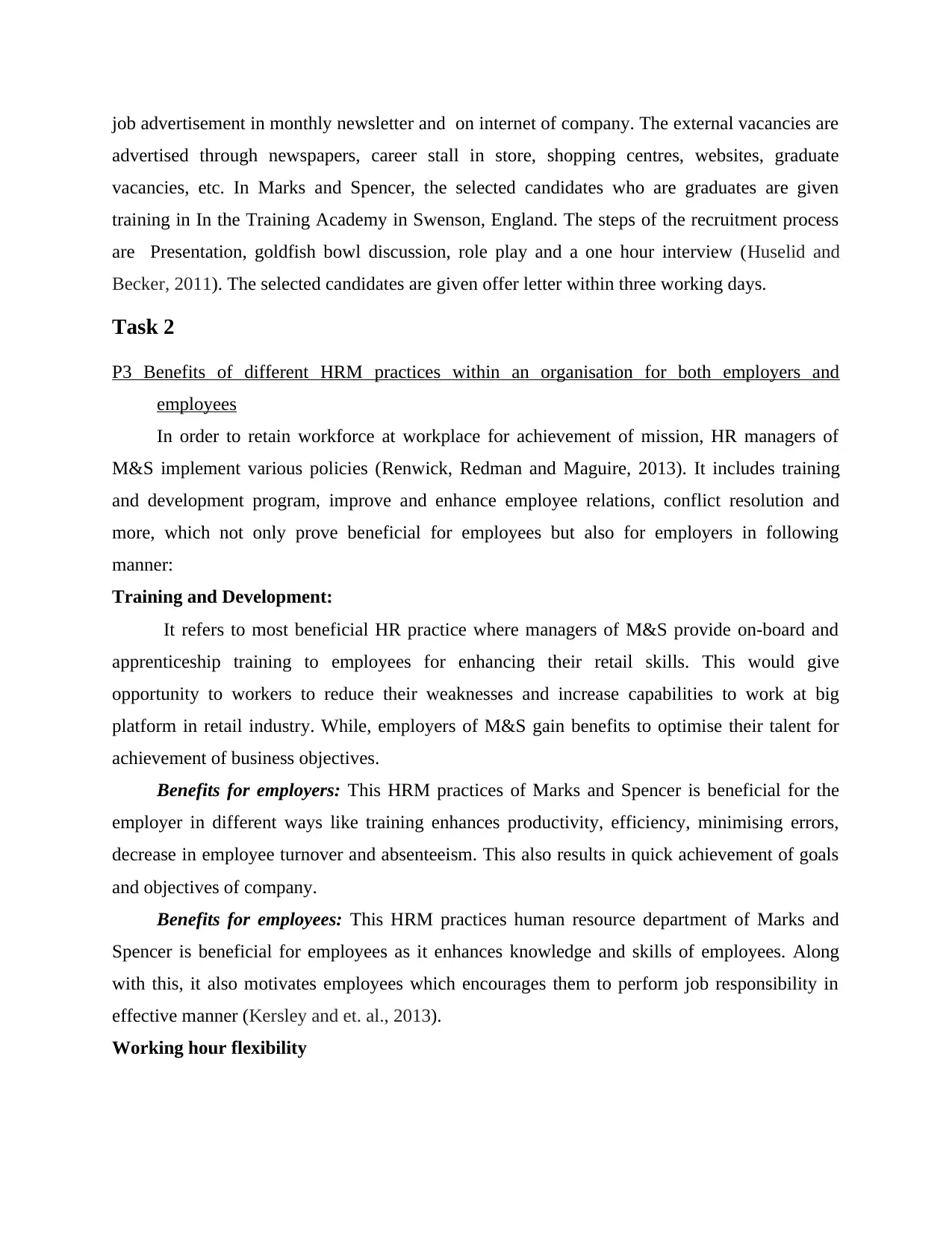
job advertisement in monthly newsletter and on internet of company. The external vacancies are
advertised through newspapers, career stall in store, shopping centres, websites, graduate
vacancies, etc. In Marks and Spencer, the selected candidates who are graduates are given
training in In the Training Academy in Swenson, England. The steps of the recruitment process
are Presentation, goldfish bowl discussion, role play and a one hour interview (Huselid and
Becker, 2011). The selected candidates are given offer letter within three working days.
Task 2
P3 Benefits of different HRM practices within an organisation for both employers and
employees
In order to retain workforce at workplace for achievement of mission, HR managers of
M&S implement various policies (Renwick, Redman and Maguire, 2013). It includes training
and development program, improve and enhance employee relations, conflict resolution and
more, which not only prove beneficial for employees but also for employers in following
manner:
Training and Development:
It refers to most beneficial HR practice where managers of M&S provide on-board and
apprenticeship training to employees for enhancing their retail skills. This would give
opportunity to workers to reduce their weaknesses and increase capabilities to work at big
platform in retail industry. While, employers of M&S gain benefits to optimise their talent for
achievement of business objectives.
Benefits for employers: This HRM practices of Marks and Spencer is beneficial for the
employer in different ways like training enhances productivity, efficiency, minimising errors,
decrease in employee turnover and absenteeism. This also results in quick achievement of goals
and objectives of company.
Benefits for employees: This HRM practices human resource department of Marks and
Spencer is beneficial for employees as it enhances knowledge and skills of employees. Along
with this, it also motivates employees which encourages them to perform job responsibility in
effective manner (Kersley and et. al., 2013).
Working hour flexibility
advertised through newspapers, career stall in store, shopping centres, websites, graduate
vacancies, etc. In Marks and Spencer, the selected candidates who are graduates are given
training in In the Training Academy in Swenson, England. The steps of the recruitment process
are Presentation, goldfish bowl discussion, role play and a one hour interview (Huselid and
Becker, 2011). The selected candidates are given offer letter within three working days.
Task 2
P3 Benefits of different HRM practices within an organisation for both employers and
employees
In order to retain workforce at workplace for achievement of mission, HR managers of
M&S implement various policies (Renwick, Redman and Maguire, 2013). It includes training
and development program, improve and enhance employee relations, conflict resolution and
more, which not only prove beneficial for employees but also for employers in following
manner:
Training and Development:
It refers to most beneficial HR practice where managers of M&S provide on-board and
apprenticeship training to employees for enhancing their retail skills. This would give
opportunity to workers to reduce their weaknesses and increase capabilities to work at big
platform in retail industry. While, employers of M&S gain benefits to optimise their talent for
achievement of business objectives.
Benefits for employers: This HRM practices of Marks and Spencer is beneficial for the
employer in different ways like training enhances productivity, efficiency, minimising errors,
decrease in employee turnover and absenteeism. This also results in quick achievement of goals
and objectives of company.
Benefits for employees: This HRM practices human resource department of Marks and
Spencer is beneficial for employees as it enhances knowledge and skills of employees. Along
with this, it also motivates employees which encourages them to perform job responsibility in
effective manner (Kersley and et. al., 2013).
Working hour flexibility
⊘ This is a preview!⊘
Do you want full access?
Subscribe today to unlock all pages.

Trusted by 1+ million students worldwide
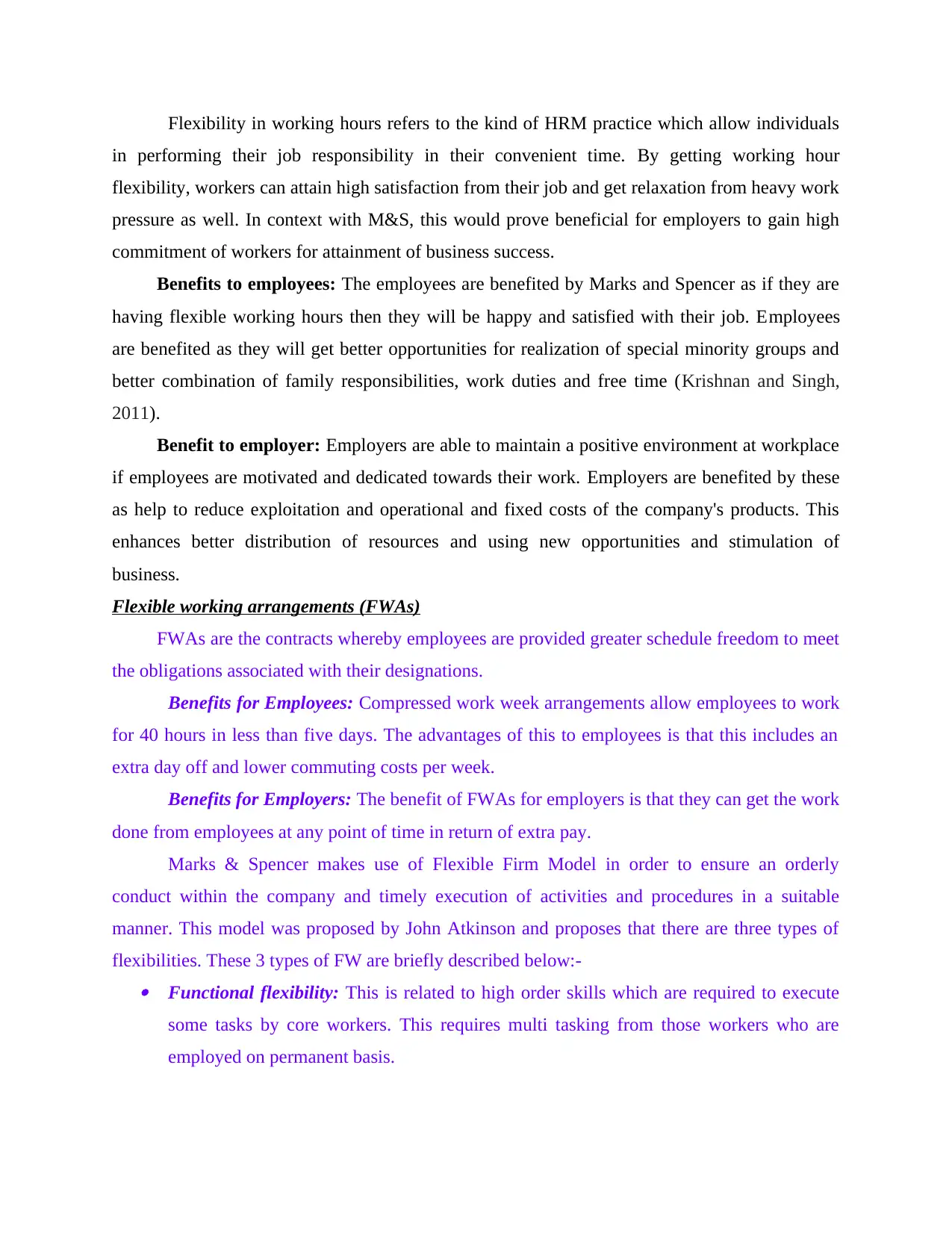
Flexibility in working hours refers to the kind of HRM practice which allow individuals
in performing their job responsibility in their convenient time. By getting working hour
flexibility, workers can attain high satisfaction from their job and get relaxation from heavy work
pressure as well. In context with M&S, this would prove beneficial for employers to gain high
commitment of workers for attainment of business success.
Benefits to employees: The employees are benefited by Marks and Spencer as if they are
having flexible working hours then they will be happy and satisfied with their job. Employees
are benefited as they will get better opportunities for realization of special minority groups and
better combination of family responsibilities, work duties and free time (Krishnan and Singh,
2011).
Benefit to employer: Employers are able to maintain a positive environment at workplace
if employees are motivated and dedicated towards their work. Employers are benefited by these
as help to reduce exploitation and operational and fixed costs of the company's products. This
enhances better distribution of resources and using new opportunities and stimulation of
business.
Flexible working arrangements (FWAs)
FWAs are the contracts whereby employees are provided greater schedule freedom to meet
the obligations associated with their designations.
Benefits for Employees: Compressed work week arrangements allow employees to work
for 40 hours in less than five days. The advantages of this to employees is that this includes an
extra day off and lower commuting costs per week.
Benefits for Employers: The benefit of FWAs for employers is that they can get the work
done from employees at any point of time in return of extra pay.
Marks & Spencer makes use of Flexible Firm Model in order to ensure an orderly
conduct within the company and timely execution of activities and procedures in a suitable
manner. This model was proposed by John Atkinson and proposes that there are three types of
flexibilities. These 3 types of FW are briefly described below:- Functional flexibility: This is related to high order skills which are required to execute
some tasks by core workers. This requires multi tasking from those workers who are
employed on permanent basis.
in performing their job responsibility in their convenient time. By getting working hour
flexibility, workers can attain high satisfaction from their job and get relaxation from heavy work
pressure as well. In context with M&S, this would prove beneficial for employers to gain high
commitment of workers for attainment of business success.
Benefits to employees: The employees are benefited by Marks and Spencer as if they are
having flexible working hours then they will be happy and satisfied with their job. Employees
are benefited as they will get better opportunities for realization of special minority groups and
better combination of family responsibilities, work duties and free time (Krishnan and Singh,
2011).
Benefit to employer: Employers are able to maintain a positive environment at workplace
if employees are motivated and dedicated towards their work. Employers are benefited by these
as help to reduce exploitation and operational and fixed costs of the company's products. This
enhances better distribution of resources and using new opportunities and stimulation of
business.
Flexible working arrangements (FWAs)
FWAs are the contracts whereby employees are provided greater schedule freedom to meet
the obligations associated with their designations.
Benefits for Employees: Compressed work week arrangements allow employees to work
for 40 hours in less than five days. The advantages of this to employees is that this includes an
extra day off and lower commuting costs per week.
Benefits for Employers: The benefit of FWAs for employers is that they can get the work
done from employees at any point of time in return of extra pay.
Marks & Spencer makes use of Flexible Firm Model in order to ensure an orderly
conduct within the company and timely execution of activities and procedures in a suitable
manner. This model was proposed by John Atkinson and proposes that there are three types of
flexibilities. These 3 types of FW are briefly described below:- Functional flexibility: This is related to high order skills which are required to execute
some tasks by core workers. This requires multi tasking from those workers who are
employed on permanent basis.
Paraphrase This Document
Need a fresh take? Get an instant paraphrase of this document with our AI Paraphraser
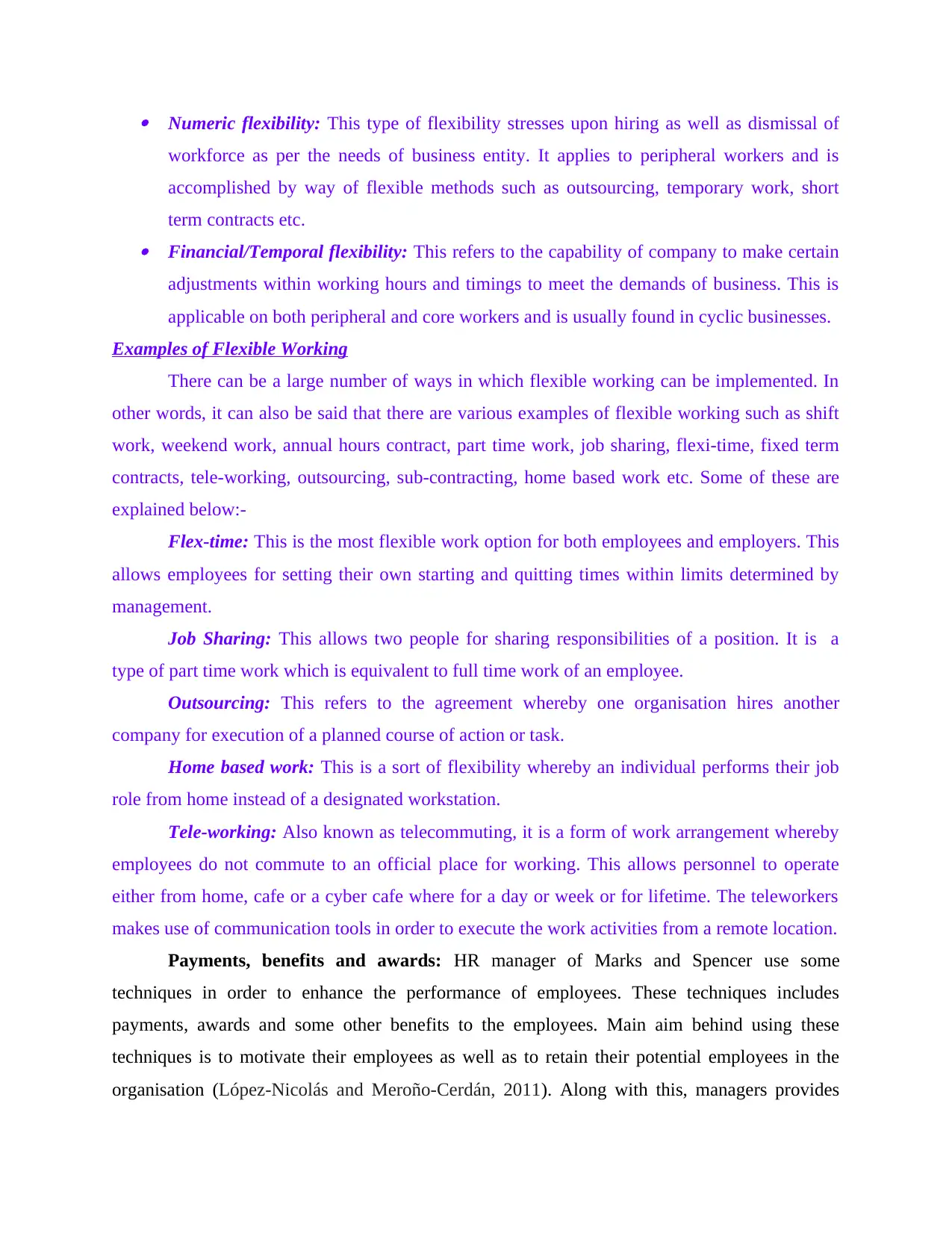
Numeric flexibility: This type of flexibility stresses upon hiring as well as dismissal of
workforce as per the needs of business entity. It applies to peripheral workers and is
accomplished by way of flexible methods such as outsourcing, temporary work, short
term contracts etc. Financial/Temporal flexibility: This refers to the capability of company to make certain
adjustments within working hours and timings to meet the demands of business. This is
applicable on both peripheral and core workers and is usually found in cyclic businesses.
Examples of Flexible Working
There can be a large number of ways in which flexible working can be implemented. In
other words, it can also be said that there are various examples of flexible working such as shift
work, weekend work, annual hours contract, part time work, job sharing, flexi-time, fixed term
contracts, tele-working, outsourcing, sub-contracting, home based work etc. Some of these are
explained below:-
Flex-time: This is the most flexible work option for both employees and employers. This
allows employees for setting their own starting and quitting times within limits determined by
management.
Job Sharing: This allows two people for sharing responsibilities of a position. It is a
type of part time work which is equivalent to full time work of an employee.
Outsourcing: This refers to the agreement whereby one organisation hires another
company for execution of a planned course of action or task.
Home based work: This is a sort of flexibility whereby an individual performs their job
role from home instead of a designated workstation.
Tele-working: Also known as telecommuting, it is a form of work arrangement whereby
employees do not commute to an official place for working. This allows personnel to operate
either from home, cafe or a cyber cafe where for a day or week or for lifetime. The teleworkers
makes use of communication tools in order to execute the work activities from a remote location.
Payments, benefits and awards: HR manager of Marks and Spencer use some
techniques in order to enhance the performance of employees. These techniques includes
payments, awards and some other benefits to the employees. Main aim behind using these
techniques is to motivate their employees as well as to retain their potential employees in the
organisation (López-Nicolás and Meroño-Cerdán, 2011). Along with this, managers provides
workforce as per the needs of business entity. It applies to peripheral workers and is
accomplished by way of flexible methods such as outsourcing, temporary work, short
term contracts etc. Financial/Temporal flexibility: This refers to the capability of company to make certain
adjustments within working hours and timings to meet the demands of business. This is
applicable on both peripheral and core workers and is usually found in cyclic businesses.
Examples of Flexible Working
There can be a large number of ways in which flexible working can be implemented. In
other words, it can also be said that there are various examples of flexible working such as shift
work, weekend work, annual hours contract, part time work, job sharing, flexi-time, fixed term
contracts, tele-working, outsourcing, sub-contracting, home based work etc. Some of these are
explained below:-
Flex-time: This is the most flexible work option for both employees and employers. This
allows employees for setting their own starting and quitting times within limits determined by
management.
Job Sharing: This allows two people for sharing responsibilities of a position. It is a
type of part time work which is equivalent to full time work of an employee.
Outsourcing: This refers to the agreement whereby one organisation hires another
company for execution of a planned course of action or task.
Home based work: This is a sort of flexibility whereby an individual performs their job
role from home instead of a designated workstation.
Tele-working: Also known as telecommuting, it is a form of work arrangement whereby
employees do not commute to an official place for working. This allows personnel to operate
either from home, cafe or a cyber cafe where for a day or week or for lifetime. The teleworkers
makes use of communication tools in order to execute the work activities from a remote location.
Payments, benefits and awards: HR manager of Marks and Spencer use some
techniques in order to enhance the performance of employees. These techniques includes
payments, awards and some other benefits to the employees. Main aim behind using these
techniques is to motivate their employees as well as to retain their potential employees in the
organisation (López-Nicolás and Meroño-Cerdán, 2011). Along with this, managers provides
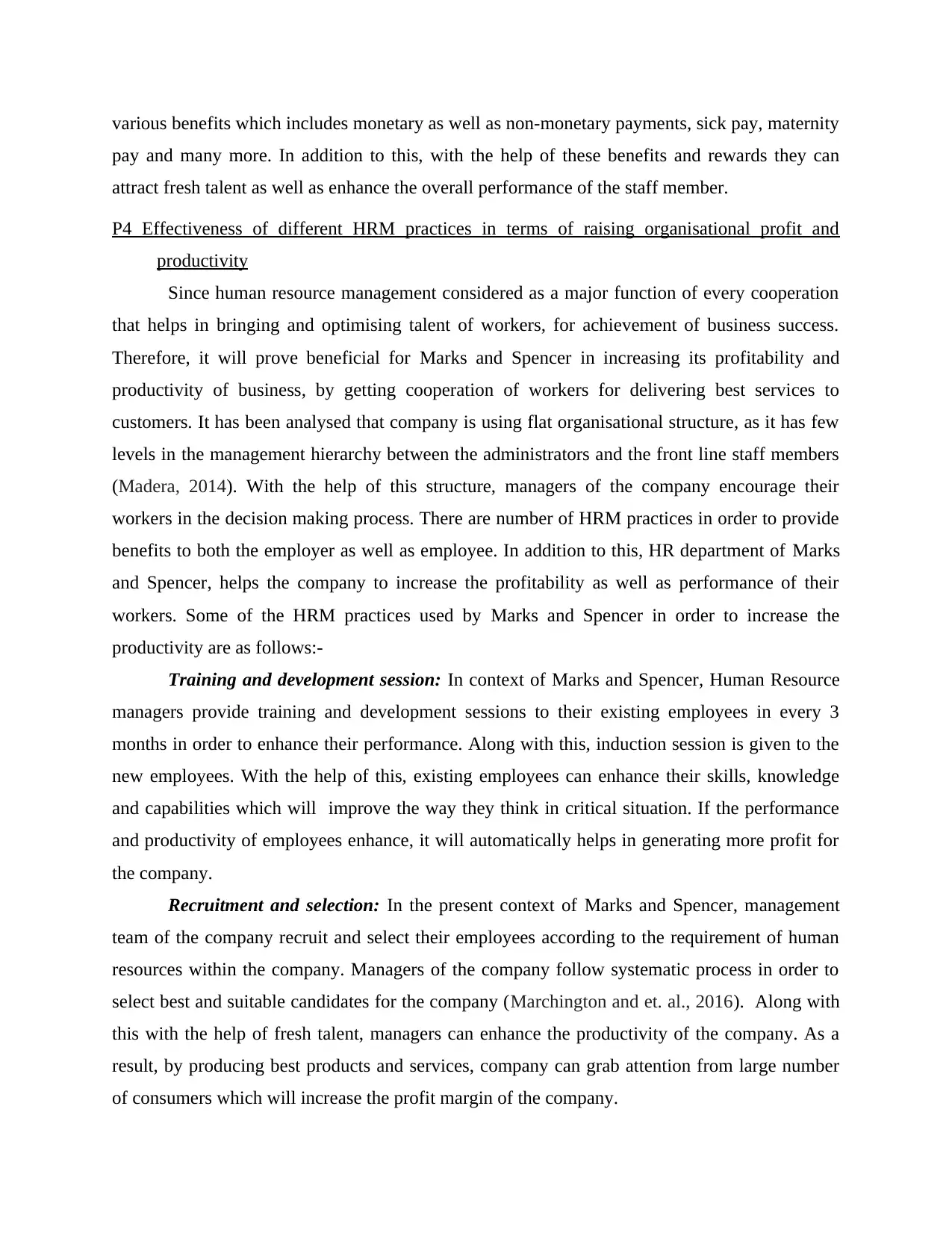
various benefits which includes monetary as well as non-monetary payments, sick pay, maternity
pay and many more. In addition to this, with the help of these benefits and rewards they can
attract fresh talent as well as enhance the overall performance of the staff member.
P4 Effectiveness of different HRM practices in terms of raising organisational profit and
productivity
Since human resource management considered as a major function of every cooperation
that helps in bringing and optimising talent of workers, for achievement of business success.
Therefore, it will prove beneficial for Marks and Spencer in increasing its profitability and
productivity of business, by getting cooperation of workers for delivering best services to
customers. It has been analysed that company is using flat organisational structure, as it has few
levels in the management hierarchy between the administrators and the front line staff members
(Madera, 2014). With the help of this structure, managers of the company encourage their
workers in the decision making process. There are number of HRM practices in order to provide
benefits to both the employer as well as employee. In addition to this, HR department of Marks
and Spencer, helps the company to increase the profitability as well as performance of their
workers. Some of the HRM practices used by Marks and Spencer in order to increase the
productivity are as follows:-
Training and development session: In context of Marks and Spencer, Human Resource
managers provide training and development sessions to their existing employees in every 3
months in order to enhance their performance. Along with this, induction session is given to the
new employees. With the help of this, existing employees can enhance their skills, knowledge
and capabilities which will improve the way they think in critical situation. If the performance
and productivity of employees enhance, it will automatically helps in generating more profit for
the company.
Recruitment and selection: In the present context of Marks and Spencer, management
team of the company recruit and select their employees according to the requirement of human
resources within the company. Managers of the company follow systematic process in order to
select best and suitable candidates for the company (Marchington and et. al., 2016). Along with
this with the help of fresh talent, managers can enhance the productivity of the company. As a
result, by producing best products and services, company can grab attention from large number
of consumers which will increase the profit margin of the company.
pay and many more. In addition to this, with the help of these benefits and rewards they can
attract fresh talent as well as enhance the overall performance of the staff member.
P4 Effectiveness of different HRM practices in terms of raising organisational profit and
productivity
Since human resource management considered as a major function of every cooperation
that helps in bringing and optimising talent of workers, for achievement of business success.
Therefore, it will prove beneficial for Marks and Spencer in increasing its profitability and
productivity of business, by getting cooperation of workers for delivering best services to
customers. It has been analysed that company is using flat organisational structure, as it has few
levels in the management hierarchy between the administrators and the front line staff members
(Madera, 2014). With the help of this structure, managers of the company encourage their
workers in the decision making process. There are number of HRM practices in order to provide
benefits to both the employer as well as employee. In addition to this, HR department of Marks
and Spencer, helps the company to increase the profitability as well as performance of their
workers. Some of the HRM practices used by Marks and Spencer in order to increase the
productivity are as follows:-
Training and development session: In context of Marks and Spencer, Human Resource
managers provide training and development sessions to their existing employees in every 3
months in order to enhance their performance. Along with this, induction session is given to the
new employees. With the help of this, existing employees can enhance their skills, knowledge
and capabilities which will improve the way they think in critical situation. If the performance
and productivity of employees enhance, it will automatically helps in generating more profit for
the company.
Recruitment and selection: In the present context of Marks and Spencer, management
team of the company recruit and select their employees according to the requirement of human
resources within the company. Managers of the company follow systematic process in order to
select best and suitable candidates for the company (Marchington and et. al., 2016). Along with
this with the help of fresh talent, managers can enhance the productivity of the company. As a
result, by producing best products and services, company can grab attention from large number
of consumers which will increase the profit margin of the company.
⊘ This is a preview!⊘
Do you want full access?
Subscribe today to unlock all pages.

Trusted by 1+ million students worldwide
1 out of 21
Related Documents
Your All-in-One AI-Powered Toolkit for Academic Success.
+13062052269
info@desklib.com
Available 24*7 on WhatsApp / Email
![[object Object]](/_next/static/media/star-bottom.7253800d.svg)
Unlock your academic potential
Copyright © 2020–2025 A2Z Services. All Rights Reserved. Developed and managed by ZUCOL.





